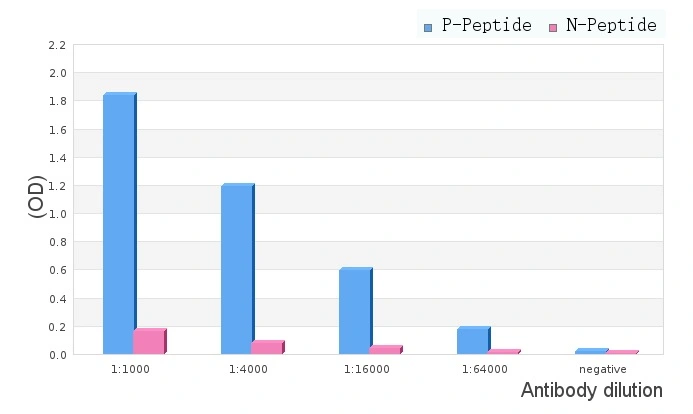HSP27 antibody
GTX101145
ApplicationsFlow Cytometry, ImmunoFluorescence, ImmunoPrecipitation, Western Blot, ImmunoCytoChemistry, ImmunoHistoChemistry, ImmunoHistoChemistry Paraffin
Product group Antibodies
ReactivityHuman, Mouse, Rat
TargetHSPB1
Overview
- SupplierGeneTex
- Product NameHSP27 antibody
- Delivery Days Customer9
- Application Supplier NoteWB: 1:500-1:20000. ICC/IF: 1:100-1:1000. IHC-P: 1:100-1:1000. IP: 1:100-1:1000. *Optimal dilutions/concentrations should be determined by the researcher.Not tested in other applications.
- ApplicationsFlow Cytometry, ImmunoFluorescence, ImmunoPrecipitation, Western Blot, ImmunoCytoChemistry, ImmunoHistoChemistry, ImmunoHistoChemistry Paraffin
- CertificationResearch Use Only
- ClonalityPolyclonal
- Concentration0.45 mg/ml
- ConjugateUnconjugated
- Gene ID3315
- Target nameHSPB1
- Target descriptionheat shock protein family B (small) member 1
- Target synonymsCMT2F, HEL-S-102, HMN2B, HMND3, HS.76067, HSP27, HSP28, Hsp25, SRP27, heat shock protein beta-1, 28 kDa heat shock protein, epididymis secretory protein Li 102, estrogen-regulated 24 kDa protein, heat shock 27 kDa protein, heat shock 27kD protein 1, heat shock 27kDa protein 1, heat shock protein family B member 1, stress-responsive protein 27
- HostRabbit
- IsotypeIgG
- Protein IDP04792
- Protein NameHeat shock protein beta-1
- Scientific DescriptionThe protein encoded by this gene is induced by environmental stress and developmental changes. The encoded protein is involved in stress resistance and actin organization and translocates from the cytoplasm to the nucleus upon stress induction. Defects in this gene are a cause of Charcot-Marie-Tooth disease type 2F (CMT2F) and distal hereditary motor neuropathy (dHMN). [provided by RefSeq]
- ReactivityHuman, Mouse, Rat
- Storage Instruction-20°C or -80°C,2°C to 8°C
- UNSPSC12352203
References
- Cui X, Sawashita J, Dai J, et al. Exercise suppresses mouse systemic AApoAII amyloidosis through enhancement of the p38 MAPK signaling pathway. Dis Model Mech. 2022,15(3). doi: 10.1242/dmm.049327Read this paper
- Xu YM, Tan HW, Zheng W, et al. Cadmium telluride quantum dot-exposed human bronchial epithelial cells: a further study of the cellular response by proteomics. Toxicol Res (Camb). 2019,8(6):994-1001. doi: 10.1039/c9tx00126cRead this paper
- Cheung CHY, Hsu CL, Lin TY, et al. ZNF322A-mediated protein phosphorylation induces autophagosome formation through modulation of IRS1-AKT glucose uptake and HSP-elicited UPR in lung cancer. J Biomed Sci. 2020,27(1):75. doi: 10.1186/s12929-020-00668-5Read this paper
- Xu YM, Wu DD, Zheng W, et al. Proteome profiling of cadmium-induced apoptosis by antibody array analyses in human bronchial epithelial cells. Oncotarget. 2016,7(5):6146-58. doi: 10.18632/oncotarget.6738Read this paper
- Huang HJ, Lin CC, Chou HC, et al. Proteomic analysis of rhein-induced cyt: ER stress mediates cell death in breast cancer cells. Mol Biosyst. 2014,10(12):3086-100. doi: 10.1039/c4mb00451eRead this paper
- Chou HC, Chan HL. 5-Methoxytryptophan-dependent protection of cardiomyocytes from heart ischemia reperfusion injury. Arch Biochem Biophys. 2014,543:15-22. doi: 10.1016/j.abb.2013.12.014Read this paper
- Lin ST, Chou HC, Chang SJ, et al. Proteomic analysis of proteins responsible for the development of doxorubicin resistance in human uterine cancer cells. J Proteomics. 2012,75(18):5822-47. doi: 10.1016/j.jprot.2012.07.047Read this paper







![IHC-P analysis of human breast carcinoma tissue using GTX22790 HSP27 antibody [G3.1]. Left : Primary antibody Right : Negative control without primary antibody Antigen retrieval : heat induced antigen retrieval was performed using 10mM sodium citrate (pH6.0) buffer, microwaved for 8-15 minutes Dilution : 1:500](https://www.genetex.com/upload/website/prouct_img/normal/GTX22790/GTX22790_1113_IHC-P_w_23060620_380.webp)